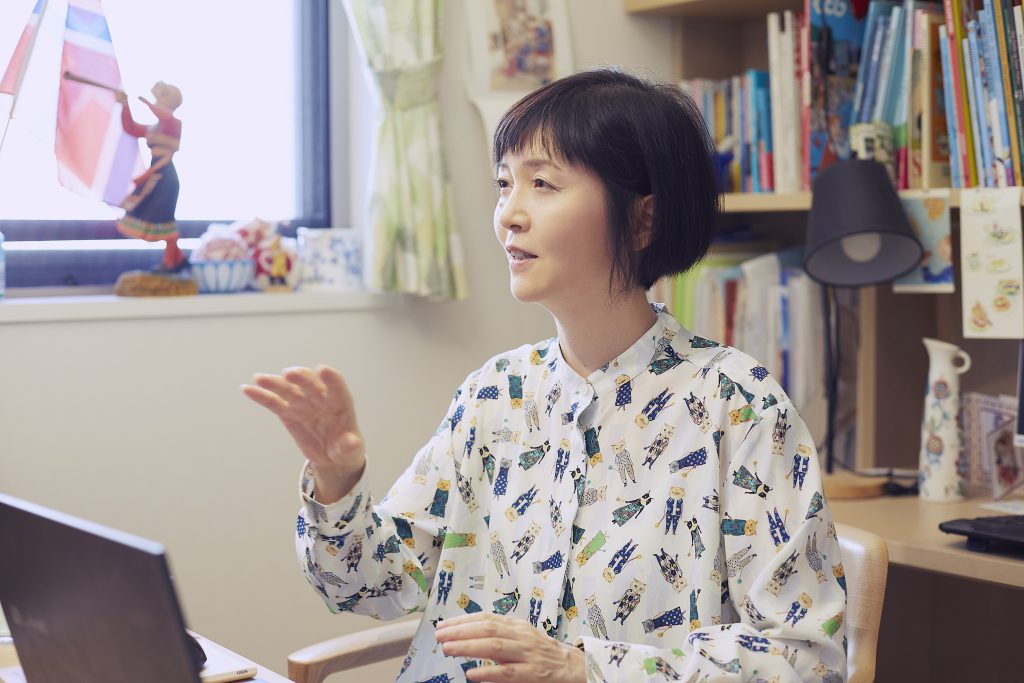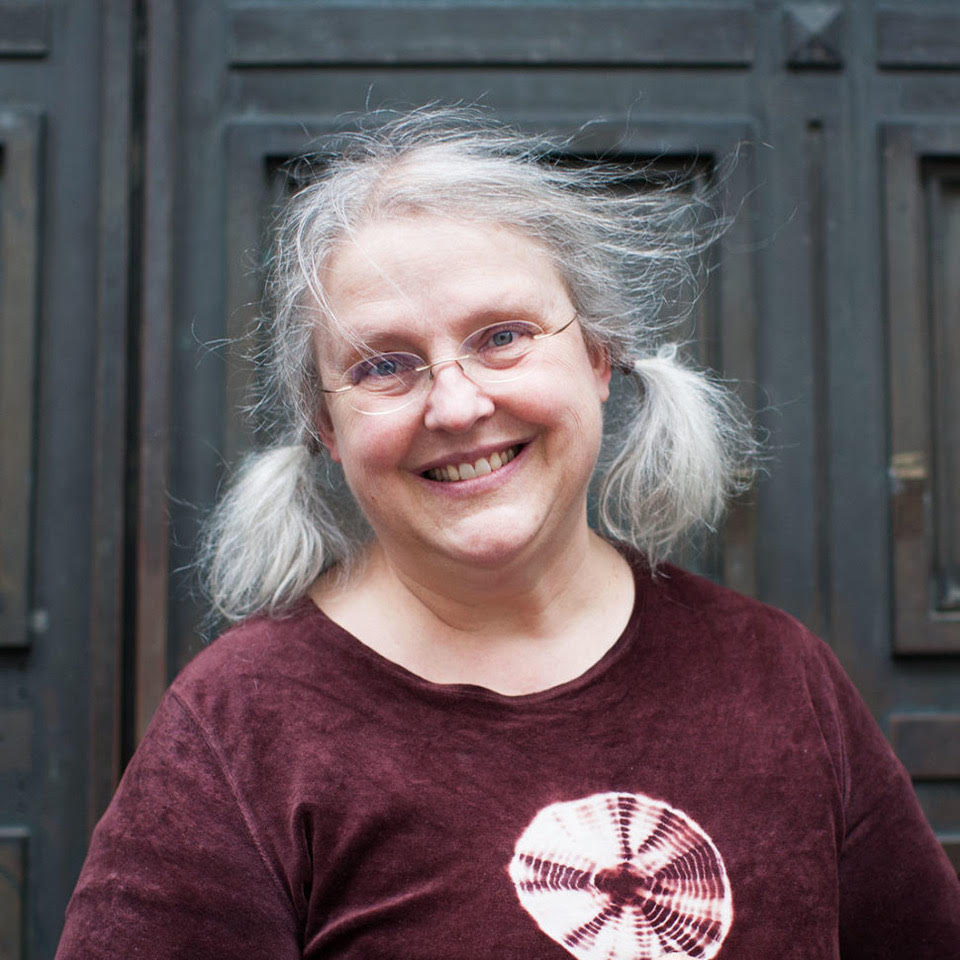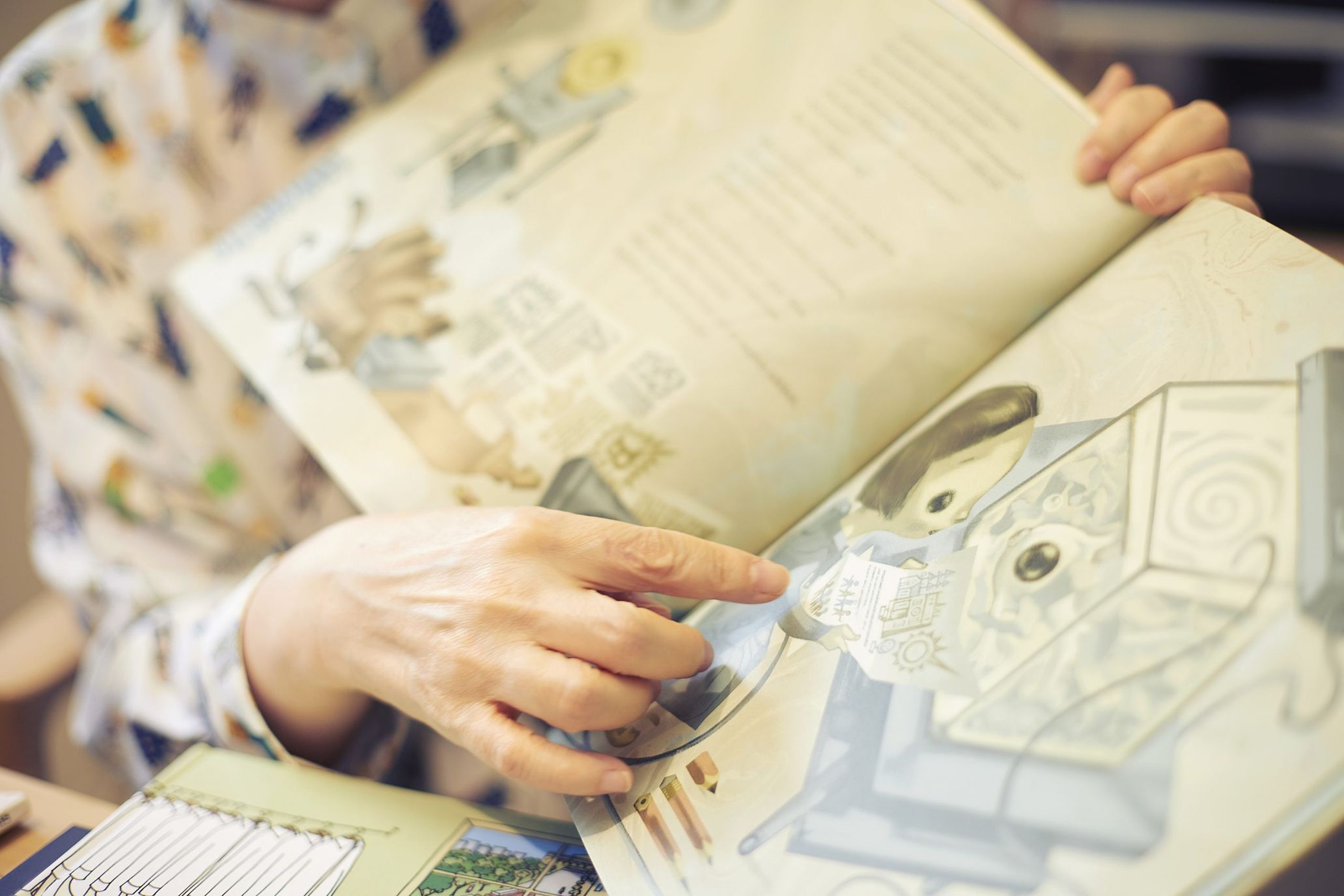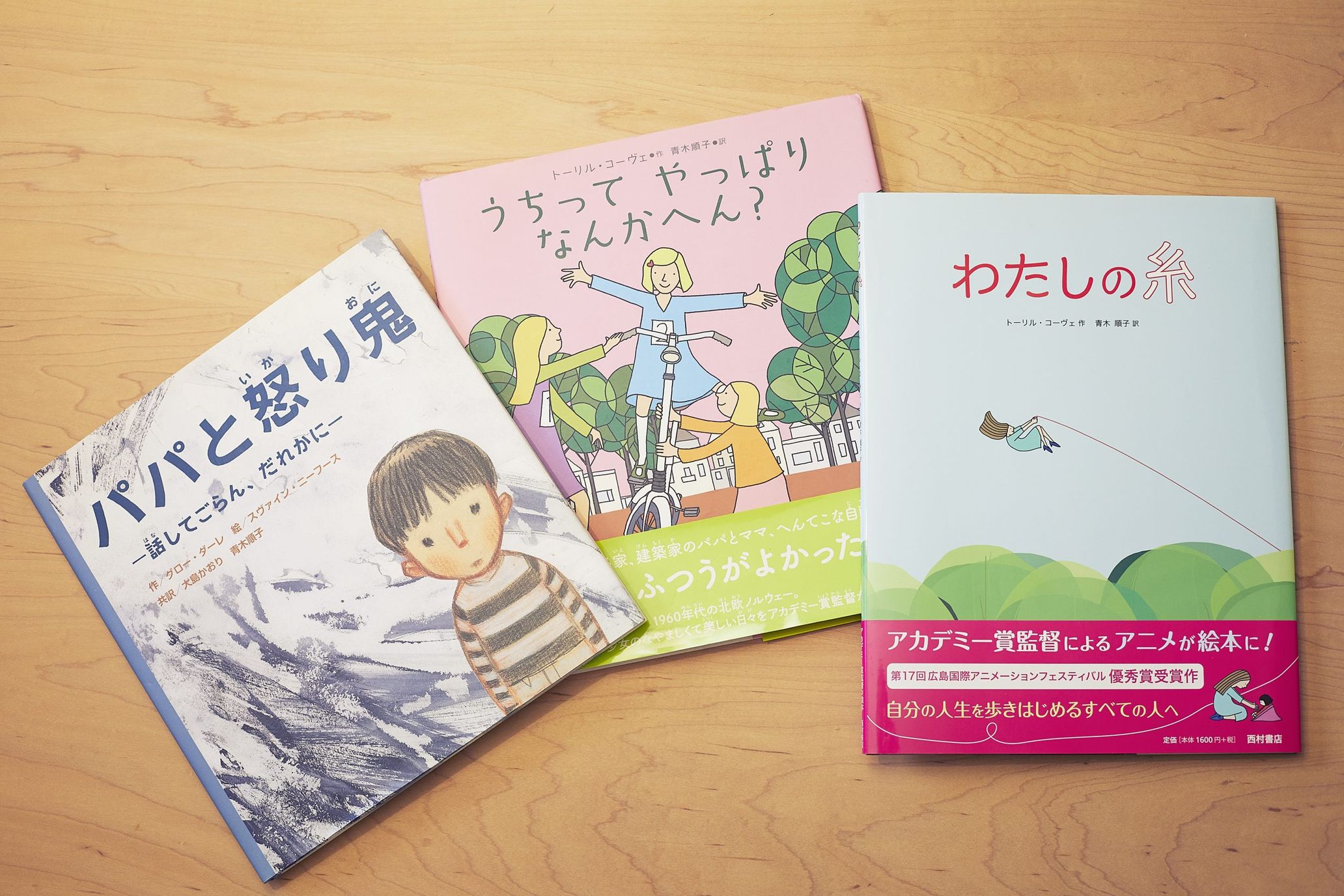The world of Norwegian picture books may be full of surprises for Japanese people as they vividly depict all kinds of social issues, including gender-related matters and domestic violence. Among them, The Angry Man captures domestic violence by parents from a child’s perspective. In Aquarium, it highlights the presence of young carers, making their existence known to society even before it gained widespread recognition.
In Aquarium, the book portrays the daily life of a young girl whose mother is a goldfish in a realistic way. The girl cares for her mother in a fish tank, always staying in proximity. Her friends don’t believe that her mother is a goldfish. One day, when the school hands out an invitation for her parents to come to school, the girl tries to take her mother with her in a bag with water. However, the water spills from the bag and the mother almost dies. Alarmed by the experience, the girl stays by the tank, can no longer eat and stops going to school. One day, the teacher, out of concern, visits the girl and brings food for her. While they are eating together, the teacher says, “Your mother is lovely,” and the story ends.
When the book was published in 2014, young carers were not widely recognized, and it portrayed a parent, who could not raise her child, as a goldfish. Revisiting the book, the characterization clearly conveys that the artist wanted to portray the existence of young carers.
While dealing with a serious subject matter, the illustrations provide a sense of hope and salvation at the end. The ability to convey warmth is the unique aspect of picture books.
The world is starting to pay attention to picture books in Norway, which deal with social issues and diversity from the forefront—topics that are rarely addressed in Japan. We interviewed Gro Dahle, the author of Aquarium and Junko Aoki, who translated the picture book Me and My Moulton and Threads by Torill Kove. Torill is an internationally acclaimed animation film director and won the Academy Award for Animated Short Film in 2007. We asked them about the appeal of Norwegian picture books and their thoughts on working on them.

Junko Aoki
Junko teaches the Norwegian language and also works as a translator, interpreter, and lecturer. She studied at the Volda National College and the University of Oslo in Norway. Since 2000, she has been running the community website “Norway Dream Net” to provide information about Norway. Junko authored many books including『ノルウェー語のしくみ<新版>』『ニューエクスプレスプラスノルウェー語』『「その他の外国文学」の翻訳者』. She is a translator of Me and My Moulton and Threads among many other works.

Gro Dahle
Gro Dahle is a poet and author, born in Oslo, Norway in 1962. She graduated from the University of Oslo and has studied creative writing at the Telemark University College. In 1987, she debuted with Audiens (Audience)—a poetry collection that was very well received. She has since become a very well-known lyricist and novelist. She lives in Tjøme in Vestfold with her husband, Svein Nyhus.
Asking “what if” upon constructing narrative expands imagination
–How did you end up translating the picture books by Torill Kove?
Junko Aoki: It all started when I saw Torill’s animated short film My Grandma Ironed the King’s Shirt on a TV program in Japan. The film is a fictionalized depiction of when Norway became independent in 1905 and chose monarchy in a referendum. As a result, Prince Karl of Denmark was welcomed as King Hakon VII of Norway along with Queen Maud. In those days, servants did not yet exist in Norway, and the royal family’s problem was that no one ironed their shirts. Then an elderly woman became a dedicated staff to iron the King’s shirts, but Norway was occupied by the Germans during World War II.
The King and his family fled to England, but called on the Norwegian people to resist the German troops on the radio. The elderly woman, who loved the king, and her friends demonstrated their resistance by making holes with their irons or adding stains on the German soldiers’ uniforms. In the end, the people defied the occupation and the German soldiers withdrew. The King and his family returned safely to Norway.
Historically speaking, the resistance movement was not the single cause, which prompted the Nazis to retreat. And it was mostly men who were involved in leading the resistance movement. However, in the book, the author wanted to illustrate women such as the elderly woman and other fellow cleaning women who resisted the Nazis in their own way to take revenge on the Germans. Even if they are not recognized in Norwegian history, it’s a fact that these nameless women also joined the resistance. Since then, I read all the books by Torill whenever they were published in Norway.
–There is another book by Torill, Threads, which is popular among Japanese readers. It depicts the relationship between an adult and a child who meet each other by a red thread. A young girl catches the thread hanging from the sky and flies through the sky. She meets an infant and they grow up together as mother and child. In the end, the main character’s daughter follows the thread and becomes independent and all of this is expressed almost exclusively in illustrations.
Junko: The story is an adventure that starts when the main character stretches her hand and grabs a thread. The animation received high praise, including an award of excellence at the Hiroshima International Animation Festival. I think Torill was compelled to produce this work after adopting a child from Asia, and the theme is the connection between people that is not related by blood. There are people of all skin colors in the scenes where the child plays, and the book does not make any reference to nationality or race, making it easy for anyone in the world to read and feel an emotional connection. Torill said, “In this book, the setting is a mother and daughter, but I want the reader to imagine freely without being bound by that setting.” The story gives us a sense that it is possible to connect with people regardless of gender and race.
–In Japan, picture books often have a target age range. However, I gathered that picture books in Norway are intended for all ages and that there is also a tradition of giving picture books as gifts among grownups.
Junko: In bookstores in Norway, picture books are not categorized by age, giving the impression that both children and grownups can enjoy reading picture books. There is also an environment where children are asked for their feedback after reading a picture book in order to foster their independence.
—The Angry Man by Gro Dahle portrays domestic violence by parents from a child’s point of view. Domestic violence is also becoming increasingly serious in Japan, and the book encourages children to seek help. I heard that this book was written based on an episode about children who grew up with domestic violence in Norway having a meeting with King Harald V. As is the case with My Grandma Ironed the King’s Shirt, there seems to be a closeness between the public figures and the people.
Junko: I agree. Some years ago, the King gave a memorable speech. He said, “In Norway, there are boys who like boys and there are girls who like girls.” Not only the King, but the Minister of Foreign Affairs visited the school of a student who sent a letter saying that he was heartbroken about Ukraine. It’s true that the population is small but there are many activities that allow the people to feel closer to their public figures.
In Japan, sexual violence is a huge problem much like in Norway. Many years ago, a politician addressed the matter explicitly on a state-run broadcasting channel, “Has anyone touched your penis?” This was an attempt to reach children, who are victims and needed support. There are many young ministers in their 30s, and when there are role models like them, it generates more interest in politics among children and makes them feel closer to the idea of becoming a politician one day.
When the picture book artists has the mastery to reveal the invisible in their work
—Recently, the term “young carer” has become prevalent in Japan, and I understand that a picture book featuring a child in similar circumstances was published in Norway.
Junko: While making school visits, Gro, the author of Aquarium, has written many books which portrayed social issues that children face. It has touched on situations where girls are forced to be well-behaved and are often burdened with the notion of “being a girl” based on the division of gender roles at home and in society. Her work includes jarring content, such as scenes of violence and sexual content. Gro believes that children have the potential to be receptive to stories.
On the other hand, some parents are wary and try to keep their children away from reading books that are too stimulating. Since it is the grownups who buy picture books for children, it is necessary to change their mindset so that her stories can be brought to the children.

–I have heard that it is common in Norway for well-known mystery writers to write novels for children. Can you tell us what kind of books are available?
Junko: Jo Nesbo, a world-renowned mystery writer whose novels have been translated into Japanese and published in many other languages, has also written many novels for children. Not only him, but other Norwegian writers actively engage in reading sessions at elementary and junior high schools and libraries, so perhaps they are naturally conscious of the need to expose children to authentic art and encourage them to read books. One children’s literature author talked about the amazing inspiration he receives from children, and said that as a result of the interaction, he created stories that anyone could easily understand, which naturally lead to novels for children. Thanks in part to the country’s strong cultural support, there are many opportunities for children to be exposed to the world of high quality narratives.
How rich the reading experience becomes for children often depends on the actions of adults, but I would like Japanese readers to be exposed to Norwegian stories in the form of translations, so that they can learn about the diversity of societies and ways of thinking.

Reasons why a renowned Norwegian author worked on picture books
–Gro, what prompted you to start creating these picture books?
Gro Dahle: I have been a well-established poet and writer of short stories and poetic prose. My work was published at Norway’s largest publishing house, Cappelen Damm, and they invited me to write stories about child neglect. The story centers around a selfish mother who just wants to have fun and her serious daughter who has to do the house chores to keep up the household. Although I received assistance from the publisher, it was a challenging project to get it right. After publishing four children’s books, it became clear to me that I wanted to write for children between the ages of five to 19. I also want to utilize my language skills and creativity to publish books that illuminate dark corners and shadows within children’s minds —harboring secrets and risky experiences they can share with no one.
I want to be there and support children in need and are in situations similar to those of the characters in my books. I hope they can become friends with the characters in my books and learn that they are not alone. I want my books to serve as lights, unlocking the doors in their minds, and dispelling shadows.
–In Aquarium, how did you come up with the idea of turning the mother into a fish?
Gro: My storytelling method revolves around the use of allegory and metaphor. Children up to the age of eleven or twelve typically interpret the story literally. As they get older, they begin to consider the characters’ emotions and relationships, examining psychological thoughts, ethics, values and codes of conduct. Adults compare the narrative to societal structure, authority, power dynamics, and aspects of identity and self-worth, and try to interpret various information by expanding their imagination through language.
In my work, like Aquarium, the allegorical method opens doors to various levels of experience, offering a spectrum of ages and different insights. For instance, the tale of Moa and her fish mom in a glass bowl appears curious and amusing on the surface. Yet, for children between the ages of 13 to 19, it represents the challenges of growing up with a mother incapable of providing essential care. Teenagers can further explore societal, and ethical aspects, drawing parallels between the wet life of a fish to, maybe, living with an alcoholic.
Children who were neglected may have flashbacks of their painful experiences and memories, recognizing signs of neglect depicted in the story. On the other hand, I can indirectly convey to readers who have not yet faced any harsh realities about the existence of these children, who are forced to live in difficult situations. The use of allegory and metaphor can foster various interpretations and discoveries within a single story.
—What are the challenges of writing children’s books?
Gro: The challenge involves maintaining a delicate balance between the adult and child perspectives. Striking a balance in language, aiming for a simplicity that is simultaneously poetic without veering into overly adult territory. This means navigating the fine line between art and psychology/pedagogy, steering clear of becoming too easy or difficult, or too banal and complex.
To achieve this, I draw inspiration from Piaget’s developmental traits of the preoperational mind, characterizing a child’s perception before the age of seven or eight. Children of this age believe in magic and recognize objects and creatures as the outside world, and understand them through a mixture of experience and fantasy. Therefore, I try to incorporate metaphors that attract children’s interest, while making it accessible for younger children and poetic for teenagers.
To craft a story that resonates with readers, I conduct extensive research, including interviews with psychologists and researchers. I also work with therapists, who share insights into the experiences of children growing up in homes with domestic violence or facing abuse.
Children freely express what they feel in words, such as portraying a sexual abuser as an octopus.
When I incorporate actual quotes from children into my story, it lends veracity and authenticity to the dialogue in the books. As a result, it makes the book more insightful and leads to a direct connection with the readers. The reason I take this approach is that I have not experienced anything that casts a dark shadow over my mind. Frequently, children express surprise, asking, “How did you know about me?” when reading characters in books such as The Angry Man, Dragon, or The Octopus. They saw themselves in the characters of the books.

